Overcoming Reservations to Find Relief

Stephanie woke up one day and was unable to turn her head to the left. After years of chronic back pain and knee pain, her condition took a turn for the worse when she was unable to drive or do her job properly. It was at this point that Stephanie finally overcame her reservations about trusting others with her care and sought out a chiropractor. Under the guidance of a friend, she made an appointment with Dr. Katie McKown in Woodlawn, VA.
“I was hesitant and nervous,” she recalls. “Dr. McKown and staff reassured me and made it easier for me to relax and get involved in my treatment.”
At Tuck Chiropractic, we take a different approach to providing care. It’s important for our patients to feel reassured and that they have a say in the care that we are providing. The collaboration and communication between patient and doctor are vital in this way. It’s our job to make our patients feel better both physically and mentally.
After Stephanie’s first visit, mobility in her neck had returned and she was able to continue to work and drive without trouble or tension. Within a few more visits, her knee and back felt better than they had in years. As someone who enjoyed an active lifestyle before her pain arose, she was able to ease herself back into running and exercising. Now, she runs 4-6 miles daily!
“I am as active as I used to be before the pain set in,” says Stephanie. “Before chiropractic care, I was in chronic pain and thought it was something I had to live with.”
We realize that taking the plunge to explore a new option of care can be scary. We do our best to educate our patients on the matter and make them feel like the right decision. When they begin to find relief, it’s easy for them to see.
“I suffered from pain for years because I struggle to trust others with my care. If I would have known how it would help me, I would have sought out chiropractic care earlier,” says Stephanie.
She adds that anyone who is in pain should not wait to find help, hoping that it will end. She advises people to seek care right away. In fact, once she started to find relief, she began to take her two sons. They had suffered from migraines and had to take medication to find relief. Since they’ve been seeing Dr. McKown, they no longer have to rely on medications to manage their migraines and they occur far and few between. Quality chiropractic care has helped her whole family live pain and medication free.
About the Writer
tech
Shooting Pains In Your Legs? Sciatica Treatment Could Help
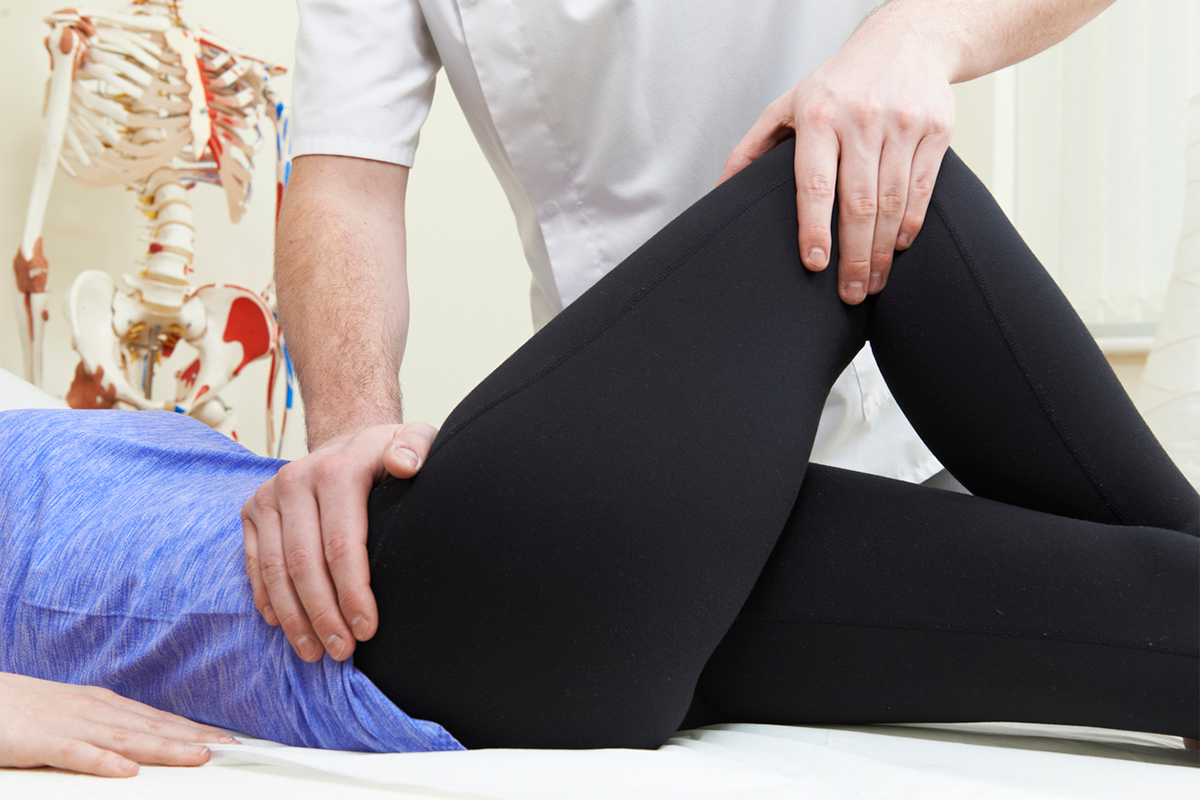
Much like the way damage to a plant’s stalk can cause damage to the whole plant, damage to your spine – specifically your lower spine – can incite pain in other areas of the body. A common example of these coexisting issues is the disorder of the sciatic nerve, known as sciatica. As one of the longest and largest nerves in the body, the sciatic nerve is protected by the spine until it reaches the lower back. At this point, it begins to split to either side of the body and branch down through your buttocks, legs, and feet. It serves as one of the main sources of sensation in your legs and therefore, when damaged, can be very detrimental to your mobility and comfort.
As you can imagine, pressure, inflammation, or slipped disks in the lower spine can greatly affect the sensations passing through this nerve and often brings great discomfort. In fact, it has been reported that 5 to 10 percent of patients with lower back pain also suffer from sciatica. Sciatica problems can express itself anywhere between the buttocks and the feet, often as tingling, numbness, or shooting pains. While the root cause is often from problems in the lower back, long periods of sitting or sudden stress to this area of the body can also trigger these sensations. The worst part about sciatica is that it is often a progressive problem, starting with light sensation and worsening over time if it is not treated.
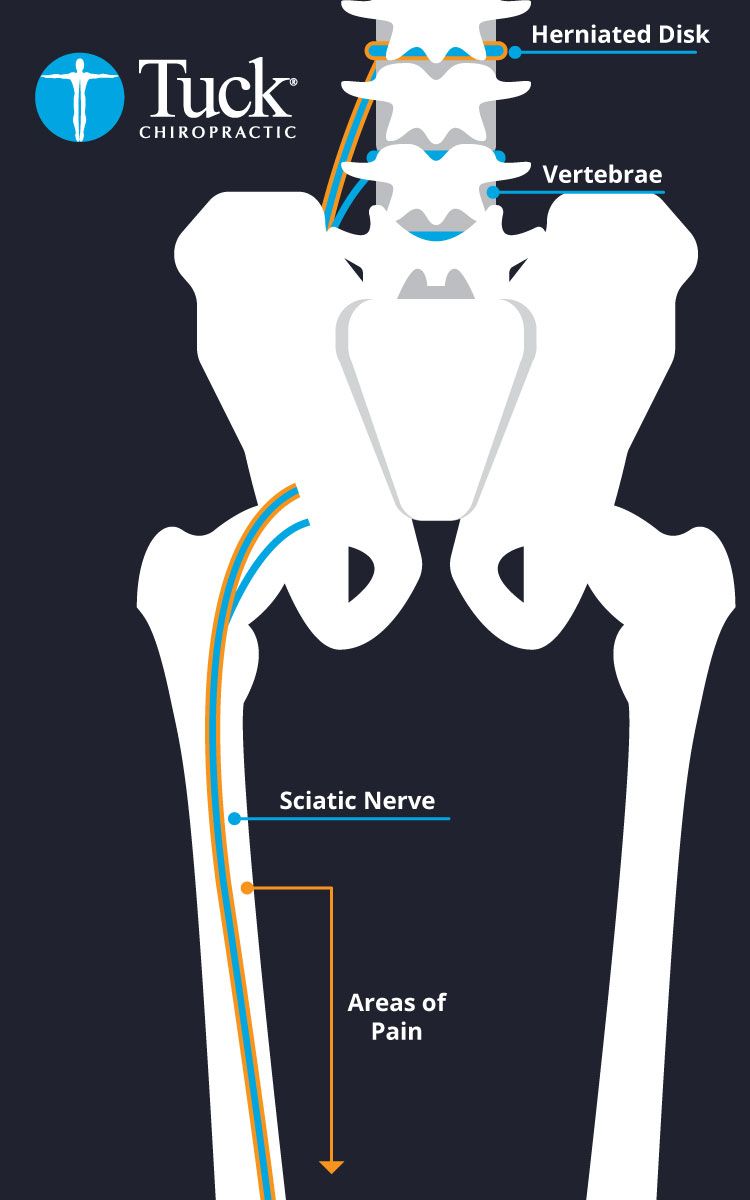
Find Relief: Chiropractic Treatments for Sciatica
Because of the close connection between the sciatic nerve and the spine, chiropractors have been treating sciatica regularly in congruence with lower back pain to find positive results in relieving pain and can often be coupled with massage therapy or physical therapy for improved results. If you’re experiencing lower back problems or early signs of sciatica, it’s important to discuss your symptoms with your chiropractor so that they can get to the root of the cause and collaborate with you on a care plan that’s right for your lifestyle. Proper diagnosis of sciatica is essential because both physical symptoms and personal lifestyle must come into play.
We take a complete history of your health to find the root cause of the problem. If you suffer from nerve damage due to disease or illness, suffer from mental stress, or live a sedentary lifestyle, you could have an increased risk of suffering from sciatica. By identifying possible sources, discussing the frequency and severity of symptoms, and provide a physical exam, we will be able to assemble the right treatment for you. Depending on your personal needs, we can then provide the right mix of heat therapies, electrical stimulation therapy, and manipulation of the lumbar spine to try to reduce stress on your lower back, and therefore inflammation that is inciting pain. Chiropractors are also trained to recognize problems that could be beyond being manageable with adjustments. At this point, we can make expert recommendations to physicians that can help.
Take Charge: At Home Treatment and Prevention Techniques
The healing process doesn’t stop when you leave the clinic. Tuck Clinic tries to fully equip patients with expectations on their healing, tips on managing pain and preventing worsening pain, and exercises to help strengthen the parts of the body that could be causing the inflammation around the nerve. With therapeutic exercises and following a few daily reminders, you can take control of how your pain relief progresses. Remembering things like sitting with your legs uncrossed, maintaining posture, avoiding being too sedentary, and eating can be key factors in helping you return to a happy healthy lifestyle!
About the Writer
tech
Progress For the Opioid Epidemic Will Come From Progressive Care

While methods of chiropractic care can vary, chiropractors have a singular focus on relieving pain through a progressive treatment plan. Ultimately, the goal is to administer adjustments to the spine and musculoskeletal system to relieve tension and realign areas of the body that are causing pain. Over time, the hope is that the relief will progress from less pain to no pain. The best thing about this method of pain relief is that the treatment plan is void of medications.
We also happen to be in the business of prevention. Through maintenance and wellness care that we provide to our patients, they can continue to live a pain-free lifestyle. Could this part of the solution in preventing opioid addiction, too? We think so. It seems that, more and more, the wider medical community is beginning to think so too.
Spreading the Word About Patient-Centered Care
Chiropractors around the world have spent their careers providing a fantastic alternative to opioid pain relievers. Our method of patient-centered care is focused on helping the patient primarily with their pain, as well as looking at their well-being as a whole. As the opioid epidemic in the United States worsens, we along with other healthcare professionals, are working harder than ever to build a bridge with doctors from all backgrounds to educate them and the public on the value of providing relief through non-pharmacological means. On a national scale, the American Chiropractic Association has rejuvenated their brand with a focus on being “Hands Down Better™”. Including communicating and collaborating with the healthcare industry at large.
In April 2017, the American College of Physicians shared research focusing on noninvasive treatments for acute, subacute, and chronic low back pain as a clinical practice guideline for physicians. The goal was to provide evidence-based recommendations for noninvasive treatment of low back pain. Recommendations included urging clinicians and patients to choose non-pharmacologic treatment such as heat treatment, massage, acupuncture, and spinal manipulation as the first line of treatment. Furthermore, they specifically claim: “Clinicians should only consider using opioids as an option in patients who have failed the aforementioned treatments and only if the potential benefits outweigh the risks…”
The Proof is in the Research
As more dollars are being distributed to back funding for research more evidence has alluded to the importance of chiropractic as a solution for pain. Research has focused on the effectiveness of spinal manipulation therapy as well as broadened techniques such as acupuncture, electrical stimulation therapy, and exercise education – all techniques the fall under the care that chiropractors can provide to patients seeking relief.
Harvard Medical School frames chiropractic as “a system of therapy focused on the structure of the body” and goes on to note that beyond adjustments, chiropractors can deliver treatments including manual or manipulative therapies, postural and exercise education, and ergonomic training while working in conjunction with primary care doctors, pain experts, and surgeons. They cite the American College of Physicians’ research report noted above as further proof of chiropractic’s effectiveness for treating pain.
In addition, the Palmer Center for Chiropractic Research has worked at length to build a body of research that demonstrates the strongest evidence to-date that chiropractic care is an effective way to treat pain and can easily be integrated with the usual medical care (UMC) plan of an individual. In 2017 alone, they published 21 publications and 17 peer-reviewed journals regarding various research topics surrounding chiropractic care in relation to pain and the integration of chiropractic into a greater medical treatment of pain.
The results provided one clear direction: utilizing a team-based case management model for patient-centered care demonstrates superior results. In one study, patients who received chiropractic care concurrently or collaboratively with medical care reported significantly better perceived low back pain improvement, overall improvement of health, and greater satisfaction with their care. To add to these results, a study focused on the process of collaborative care itself showed that clinicians and chiropractors found that the team-based approach enhanced information flow, social support, and interaction between patients and collaborating provider, ending in enhanced results for the patient.
In the wake of the increasing concern surrounding opioid addiction and these new research findings, the Food and Drug Administration has begun to recommend chiropractic care as part of pain management programs. Their statement encourages healthcare providers to be knowledgeable about the wider range of therapies available to patients in pain and should be used as part of a multidisciplinary approach to pain when appropriate.
While there is still a long road to travel towards recovery from the epidemic, the chiropractic disciplinary and healthcare industry at large are now taking their strides together.
About the Writer
tech
Avoiding Back Pain During Summer Travels
Sweet summertime – a time for beautiful sunsets across new horizons. It’s the perfect opportunity to discover a new beach town or hop on a plane to the Grand Canyon. While you’re relaxing on vacation, it’s important to make sure you come back feeling in better shape than when you left. Unfortunately, this isn’t always the case. Sitting for long hours in a car or on a plane can take a toll on your body. But there are a few ways you can make sure that your summer travels don’t leave you with pain.

Protect Your Neck
Sitting idly in a vehicle can encourage bad posture and put a strain on your neck and shoulders. Especially when on a long flight or car ride, it’s important to protect your neck. Prolonged strain on your neck could cause you to lose sleep and make you quite uncomfortable during your vacation. We can’t have that now, can we? There are a few key ways to keep your neck happy and healthy.
When in the car, it’s easy to hunch forward. Make sure you sit back in your seat and take advantage of your head rest. Your headrest should be placed so that it supports the entire back of your head and neck. Also, when you’re driving, be sure to keep your hands at 4 and 6 to keep your arms and shoulders from straining. If you’re relaxing as a passenger in a car or on a plane, try to always use a neck pillow to support you if you plan to nap. Letting your neck hang or even laying up against the door can damage your neck.
Protect Your Back
It’s easy to twist and turn your body when you’re locked into sitting for long periods of time. While you think you’re getting comfortable, you’re really just putting a strain on your back! We often see patients before and after long trips because of the toll it takes on the back. That being said, if you are mindful during your trip and protect your back properly, you can avoid pain.
Once again, the best advice we can give you is to sit up straight! It’s easy to slouch or want to change positions during your ride. Sitting up straight with your feet flat on the ground is the best way to protect your back. Car seats don’t always have the best lumbar support, so bringing a lumbar pillow to relieve the pressure on your lower back is a helpful technique as well.
Finally, it’s important to stop frequently to stretch. We get it, you want to get to the beach as fast as you can. But is it really worth it for your back to be in pain by the time you get there? When possible, take frequent pit stops. Get up and move your legs to get the blood flowing and even do some stretches. Your back will thank you later.
Beware of Weekend Warrior Syndrome
It’s easy to get carried away with trying to cram as much activities as you can on vacation or even during a long weekend. If your job typically requires very little activity, you might put your body into shock by bursts of activities on the weekend or on your vacation. This is known as weekend warrior syndrome and is one of the most common sources of sudden acute back pain. Remember that it’s important to pace yourself. Maybe if you’re a little out of shape, you should skip risking your back only to wipe out after 30 seconds on a wakeboard. You can have plenty of fun relaxing and taking in the sights, and you won’t have to go back to work in pain!
If you do find yourself having difficulties getting through long trips, we’re here to help! Our doctors can provide spinal adjustments to your neck and back to get you back to feeling good and looking forward to your next adventure!
About the Writer
tech
Finding Balance Between Sitting and Standing at Work
There is an endless supply of articles across the internet, and even on the Tuck Clinic Wellness Tips Blog, that recommend more time spent standing to combat lower back pain. While it can provide a great amount of relief from the pressure your lower back experiences from sitting, it certainly isn’t the end-all-be-all for back pain. Just ask Kristi Alvacorn, a teacher, who spends even more time standing at her occupation than sitting.

Kristi has been visiting Dr. Foster at Tuck Chiropractic Clinic in Bedford, VA for about a month and a half. As a teacher who stands a large percentage of the day, Kristi has had trouble standing up straight during class because of an extremely tight lower back. While she ultimately alternates between sitting and standing throughout the day, there was some sort of missing link that was preventing her from finding relief from her pain and tightness. It would seem that the missing link was chiropractic care!
This isn’t Kristi’s first round of seeking chiropractic care. She had visited a doctor in New York before she relocated to Southwest Virginia. When her pain returned, she didn’t think twice about finding a chiropractor that could see her quickly and would accept her insurance.
“It’s always very welcoming when you come in, so that’s nice. They almost know our name automatically when you walk through the door for your first visit,” said Kristi about her first appointment. “Dr. Foster talked me through the paperwork, provided a prognosis, and my first treatment on the spot.”
The Tuck Clinic Difference
Though Kristi had been to a chiropractor before. There was one element of her first visit that really set Tuck Clinic apart from the experience she had had before. Because Kristi had acute lower back pain, Dr. Foster bypassed any X-Ray imaging of her spine. In alignment with the American Chiropractic Care’s Five Pillars of Choosing Wisely, Tuck Clinic does not request X-Ray imaging on patients unless the pain experienced by the patient triggers a pre-determined list of red flags.
“At the other chiropractor, I went through a whole series of x-rays every time I went so it was nicer not to have to worry about that,” says Kristi.
Within the first three visits in the first week that Kristi had with Dr. Foster, she could feel a major difference. With the help of electrical stimulation and spinal manipulation, Kristi got over her first hurdle to find relief. Now, Kristi is down to one visit a week with therapeutic exercises on her own time. She also notes sleeping better after learning the positions she should sleep in for relief.
“I skipped last week and now I can feel the difference,” says Kristi. “I’m looking forward to enjoying my summer now!”
When asked if she had advice for anyone considering chiropractic care, she shared that it’s important to be persistent and consistent. Healing is a process and if you skip an appointment when your body isn’t ready, you’ll notice the difference.
About the Writer
tech
Finding Pain Relief During Pregnancy: Why You Should Consider Chiropractic Care
There are few instances in life that bring about as many changes as pregnancy. Expecting mothers will experience extreme changes to their bodies and emotions. While developing a baby is extremely beautiful and exciting, your body goes through many, sometimes painful, changes. In this post, we will show you how and why chiropractic care can be a source of relief for the uncomfortable changes that many expecting mothers endure.

Changes
When a body adapts to accommodate the development of a baby, it’s often an uncomfortable process for the mother. Not surprisingly, as their bodies changes, many expecting mothers feel various degrees of back and neck pain.
Pain associated with pregnancy varies from mother to mother. The discomfort is due to drastic body shape changes, leaving expecting mothers more prone to joint pain caused by altered positioning of the vertebra. Some mothers find the pain is mostly in their lower back, while others experience neck and leg pain. No matter where the pain is felt, it can almost always be associated with the changes occurring in the spine due to added weight, hormone changes, or changing balance.
Thankfully, many mothers-to-be have found relief with chiropractic care. Chiropractors know spines and can offer relief without invasive prescriptions that are dangerous to mother and child.
Why Chiropractic
There are many benefits to seeking chiropractic care while pregnant. Most importantly, a chiropractor can assure that your spine is properly aligned and able to support the development of a baby.
There are many misconceptions about the safety of the mother and child when using chiropractic care during pregnancy. However, chiropractors are trained to work with women who are pregnant and are fully capable of treating them safely. Often times, mothers have found relief and even an easier birth after consulting with a chiropractor.
For expectant mothers who wish to avoid taking pain-relieving drugs, chiropractic care is a safe, natural alternative. Chiropractic treatment can significantly reduce pain and discomfort during pregnancy by realigning the body and relieving pressure that causes lower back pain.
If you or someone you know is considering seeking out chiropractic care during pregnancy, rest assured that you will be in good hands. At Tuck Chiropractic Clinic, we are committed to providing high-quality treatment for you and your growing family.
Interested in more information? Read more about our services for expecting mothers.
About the Writer
tech
Five Tenants of Choosing Your Care-provider Wisely
As active leaders in both the chiropractic and wider medical industries, we take pride in being first in line to educate patients, the public, and anyone who will listen about the importance of providing supportive, conservative care to patients in need. While we do our best to go above and beyond for all of our patients, that doesn’t always mean providing more care than we need. To us, conservative care means finding the right treatment for an individual’s specific needs and nothing more.

Choosing Wisely
This concept is closely aligned with the American Board of Internal Medicine‘s (ABIM) Choosing Wisely initiative. Their most well known initiative, Choosing Wisely was built to address “waste” in healthcare. While no moment spent with a patient is wasted, it is often found that patients may receive more care or treatment than they actually need. Their official mission is “to promote conversations between clinicians and patients by helping patients choose care that is:
- Supported by evidence
- Not duplicative of other tests or procedures already received
- Free from harm
- Truly necessary”
While it is your choice to choose what type of practitioner to seek, it’s our duty as leader in the chiropractic industry to discuss the fives ways you can be assured that you are “Choosing Wisely” when choosing your chiropractor based on the ABIM’s recommendations for chiropractic care:
1. Do not obtain spinal imaging for patients with acute low-back pain during the six (6) weeks after onset in the absence of red flags.
Chiropractors who closely follow best practices will look for red flags before recommending spinal imaging. Because imaging tests often incur additional cost of care, it is in the best interest of the patient to refrain from imaging unless there are extenuating circumstances that lead the doctor to believe it is absolutely necessary. Red flags can include history of cancer, a possible fracture, progressive neurologic symptoms and infection, as well as conditions that potentially preclude a dynamic thrust to the spine.
If your chiropractor requests x-rays when you are not experiencing chronic low-back pain or suspect a possible fracture, you may want to ask additional questions or seek another practitioner.
2. Do not perform repeat imaging to monitor patients’ progress.
Again, unnecessary imaging incurs unnecessary cost. Unless you are being seen for a severe, ongoing problem such as scoliosis, there is no need to leverage additional x-rays to track outcomes. At Tuck Clinic, we choose to track our outcomes by reviewing a combination of the custom care plan we provide to the patient as well as their perception of their treatments and the relief resulting from such treatments.
3. Avoid protracted use of passive or palliative physical therapeutic modalities for low-back pain disorders unless they support the goal(s) of an active treatment plan.
That sounds like a lot of chiropractor jargon, don’t you think? We’ll break this one down for you. Often times, chiropractors administer passive techniques such as heating and cooling, electrical stimulation, or ultrasound therapy to supplement chiropractic adjustments. These, alone, are not the solution to fixing the overall wellness of your body after an injury or even during maintenance visits. It is highly suggested that these treatments are paired with a therapeutic exercise program that empowers the patient to continue their wellness efforts outside of the office walls. After all, the ultimate goal is to get our patients feeling better and living better overall.
4. Do not provide long-term pain management without a psychosocial screening or assessment.
There are many common causes to long-term pain. Sometimes, it’s a severe injury that has been ignored for years. But sometimes, it could be the unexpected side effects of depression or anxiety. It is the duty of a chiropractor to do their due diligence to get to the root cause of pain, even if it includes a psychological issue.
5. Do not prescribe lumbar supports or braces for the long-term treatment or prevention of low-back pain.
As noted in our recent examination of low back pain and lumbar support devices, these are great tools for temporary support but should never be considered a long term fix for an issue. Providing passive support for the lower back with these devices have been shown to reduce strength in the back, leaving it even more vulnerable to pain and injury. If your doctor has prescribed one of these devices as a quick fix, you may want to seek an alternative opinion.
About the Writer
tech
A Lifelong Search for a Feel Better, Live Better Lifestyle
At Tuck Chiropractic Clinic, we often find ourselves building relationships with our patients beyond the day to day treatments and transactions. We get the opportunity to get to know our patients outside the Clinic walls and hear their stories beyond just how they ended up in our office.
Skip Hebert is no exception! Skip is a retired veteran and avid adventurer. Sometimes, his adventures lead him to bike across the Western Coast of the United States and other times, his adventures lead him to pay a visit to the Tuck Chiropractic Clinic in Botetourt.
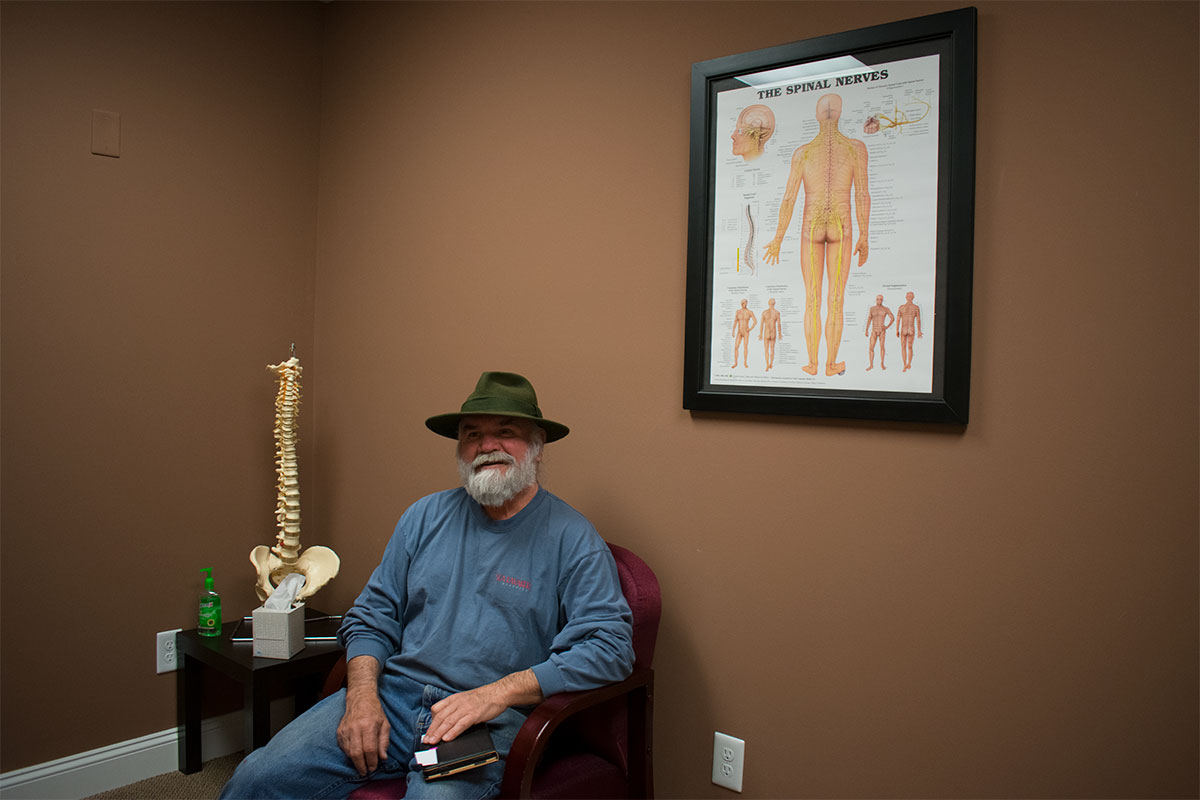
From the Open Road to the Operation Room
In 2001, Skip took on the challenge of a cross-country bike trip from the mid-West to Oregon’s coast. Before he could reach his final destination, his back decided that it had other plans for him. He had blown a disk in his lower back and received surgery to help correct it. He ended up sedentary and managing the pain with painkillers for about a month of recovery. As he continued to recover, he worked at a low-activity job, gained a lot of weight, and continued to visit the VA Clinic to receive medication for his lower back pain.
At some point, he said, “enough is enough”. His lifestyle wasn’t helping him feel better and neither was the medication.
“They kept giving me painkillers to treat the symptom but never got to the root cause of the pain,” he recalls.
Finding New Ways to Feel Better, Live Better
Skip decided to make a change in his life. He started doing yoga and even became a certified instructor. With his return to an active lifestyle, he lost fifty pounds and made plans to finish the bike trek he had to abandon after his injury.
Unfortunately, no amount of yoga can totally relieve you from the pain of a severe back injury. It may come and go, but it will never go away. In February, Skip spent a lot of time at his house chopping up wood to warm his home. Shortly after a long day of hard labor, he hopped on a plane to Florida for vacation but found himself glued to the couch due to severe neck and back pain. Luckily, his brother, a rheumatologist recommended a chiropractor to see him immediately while he was in Florida. After a manipulation and massage, he was convinced this was the last piece of the puzzle to help him live a pain-free lifestyle.
Once Skip was able to return home, he immediately sought out recommendations for a local chiropractor. As he was leaving the Carilion Wellness Center in Botetourt, he noticed that Tuck Clinic was right across the street! He called up his doctor for a referral through his Medicare program and set his first appointment.
Dr. Anna Flynn sat down with Skip to talk about his history of back pain and any other issues he was experiencing. After 5 spinal manipulation treatments in the first week and a half, coupled with electrical stimulus treatment, and therapeutic exercises, Skip not only regained mobility in the painful areas of his back, neck, and shoulders, but the pain itself began to subside too. Skip now sees Dr. Flynn once a week and plans to digress to monthly maintenance care or as needed.
“By the middle of the second week, I was feeling pretty good,” says Skip. “Now, I can’t really detect it unless I look for it.”
Getting to the Root of The Pain
Now, Skip is able to get back to his active lifestyle of adventuring and traveling. He plans to continue his journey of exploring yoga and it’s benefits to the body. With the improved mobility in his neck and shoulders, he’s also able to partake in his favorite therapeutic pastime, painting!
When we asked Skip what advice he would give to anyone considering choosing chiropractic care to help with their pain, he said “If your symptoms have anything to do with a neurological issue or pain, don’t just treat the symptom. Try to get rid of the cause. Chiropractic care is the natural way to go.”
“The folks at Tuck Chiropractic are very friendly and understanding. Dr. Anna truly listens to what the problems are and is willing and able to help resolve them,” he added.
We’re definitely looking forward to hearing about what adventures this life loving veteran gets himself into next!
About the Writer
tech
How to Keep Your Workspace Healthy

The average workweek of 40 hours per week equates to almost 24% of your year is spent at your office or place of work. If you are spending a quarter of your year in the workplace, it becomes important that said place is not wearing on your mental and physical health. Let’s look deeper into how you can better care for your body and mind while at work.
Keep Moving
Stretching, in general, is important for the muscles in your body. Stretching becomes very important when you are at work if you are sedentary for a long amount of time. Neck and back problems are most commonly associated with long periods of sitting. Sitting puts a lot of pressure on backs which can lead to back muscle pain. The disks in your back that are meant to expand and contract with movement, become compressed which causes them to lose flexibility over time. Avoiding long periods of sitting will help prevent lower back pain.
Hip problems are also a side effect of sitting for long periods of time. Sitting causes your hips to tense up and limits their range of motion. The decrease of hip mobility is one of the leading cause of elderly falls. It is strongly advised to take regular breaks in your workday to stretch the muscles you are straining or completely not using.
There are hundreds of simple office stretches you can do to counteract the side effects of prolonged sitting. Here are some of our favorites.
Create a Mental Safe Space
Your desk may be contributing to your work rut without you even knowing. You might find yourself distracted by clutter that you haven’t had a chance to clean up. You may also be feeling a little uninspired by your sterile surroundings. What does the science say about how your workspace affects your mood?
The data is split. It’s been repeatedly said that a clean desk sets us up for better organization and increased productivity. However, creative geniuses have been known to be extremely messy. Researchers at the University of Minnesota conducted a study about work surroundings that focused on unique uses for ping pong balls that found, “Participants in the messy room generated the same number of ideas for new uses as their clean-room counterparts. But their ideas were rated as more interesting and creative when evaluated by impartial judges”.
Your best results will depend on your preference. Naturally organized individuals find clutter and mess to be distracting and stress inducing. Not so organized folks tend to produce better ideas in an environment that isn’t so tidy. The point, however, is to be sure you are doing the method that best suits your personality. There is no benefit in trying to fit the standards of others as this will most likely leave you feeling uncreative or mentally stressed.
Be Aware of Office “Health” Trends
Trending in offices everywhere is the concept of a standing desk. These seem like the answer to the prayers of many individuals who suffer from lower back pain after a day at the office. Well once again, the science is split. Sitting for more than 6 hours a day has significant negative health associations, but so does working at a standing desk for the same amount of time.
Dr. Peter Ottone, a chiropractor from New Jersey, told Business Insider that “weight gain and carpal tunnel syndrome as well as shoulder, back, and neck pain are all conditions that can be affected by standing and sitting”.
The conclusions for the standing desk should be to do what’s comfortable for you. A good suggestion would be to sit when you feel yourself getting tired and distracted by the fact that your standing. On the flip side, be sure to get up and stretch your legs and get some work done that doesn’t require you to be completely sedentary.
Do a Little Research
The best way to keep your workspace health friendly? Stay informed. If you are feeling the physical or mental strain at work, look to sources that will keep you up to date on ways help make your work day pleasant. Don’t ignore what your mind or body is telling you. Mental and physical health are key to being the most productive and happy YOU!
About the Writer
tech
Desk Friendly Stretches for Your Entire Back
So many people spend long days at work sitting – 86% of Americans to be exact – that there’s a non-profit organization centered around getting desk workers to stand up! According to JustStand.org, claims that people spend an average of 12 hours sitting each day!
Sitting is often a major contributor to back pain. When we’re focused on the task at hand and often working on a computer, we tend to hunch over and put pressure on our lower back. While it’s important to get up and walk around about once an hour to get your heart rate going, it can also be helpful to get a little stretching in! You can take care of your daily stretch session right at your desk with these moves:
Neck Stretches
Neck Rolls are one of the easiest stretches you can do! The trick is to move slowly to make sure you aren’t putting too much fast pressure on your cervical spine. Slowly lower your ear to your shoulder. Hold here for a deeper stretch or continue to lower your chin down and across to your other shoulder. Reverse and repeat!

The Neck Grabber is a great way to open up the back of your neck, trapezius muscles, and between your shoulder blades. Lace your fingers and place your hands so that the bottom of your index finger rests where your skull meets your spine with your thumbs loosely on your neck. As you lower your chin to your chest, bring your elbows towards one another in front of your face and hold. As a counter stretch, you can then raise your chin up, open up your arms and shoulders, and push your chest out. Move back and forth between positions as desired.
Shoulders & Upper Back
Over the Head stretch will loosen up those hunched over shoulders and relieve pressure from the lower back. Simply interlace your fingers with your palms facing upwards and outstretch your arms! If you pretend your arms and head are attached to a puppet’s string, you can stretch even further.

Eagle Arms are a great way to stretch out between your shoulder blades. With your arms straight, cross your arms over one another. Then, bend at the elbows to bring your arms to 90 degrees. The back of your hands should be facing one another. For a deeper stretch, you can twist your arms at the wrist to bring your hands into a prayer position. Once you’re here, you can move your elbows up and down to really work your upper back and shoulders!
Low Back Stretches
Sitting Pigeon and Knee Ups are a great way to let some pressure off of your lower back and loosen up your Iliotibial band that can impact symptoms of sciatica. For knee ups, all you have to do is sit with your back flush to your chair and your feet flat on the ground. Simply raise one knee up towards your chest while maintaining your posture. You can use your arms or hands to hook under your thigh or knee if needed.
To take this another step further into the pigeon, just rest your foot or ankle across on your other knee. Leaning forward with a straight back can intensify the stretch in your lower back if needed.
A Seated Twist can ultimately stretch your entire back if your flexibility allows. With your feet firmly planted on the ground, use the arms of your chair as leverage to pull your body around. Wait until your shoulders are turned as much as possible before extending the stretch through your neck and head. It’s important to maintain your posture during this stretch to get the full effect.
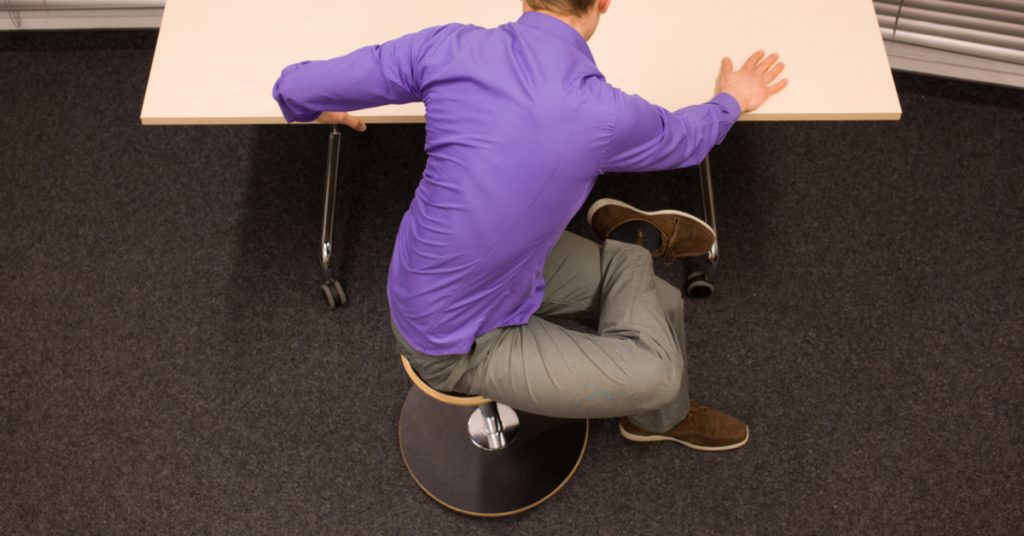
Bonus Stretch: Wrists and Hands
Carpal tunnel and tendonitis are common results of working with a mouse and keyboard for extended periods of time. These little exercises can loosen up the tendons that tighten up from repetitive work.
Wrist extensions can stretch out the four tendons in your wrist easily. Stretch your arm out in front of you with your palms facing upward. You can use the edge of your desk or your other hand to pull your fingers downward towards a 90-degree angle.
Prayer Hands is another way to achieve the same stretch by using your hands as leverage against one another. To extend the effects of this stretch, you can fan out your fingers and pull them back together to work the carpal bones.
About the Writer
tech
You may also be interested in...

What Does a Healthy Spine Feel and Look Like?
Your spine is the backbone of your overall health—literally. It supports your body, protects your nervous system, and helps you move with… Read More

How Do Chiropractic Adjustments Work?
Chiropractic care focuses on the health and alignment of the spine, recognizing its vital role in overall well-being. A central component of… Read More
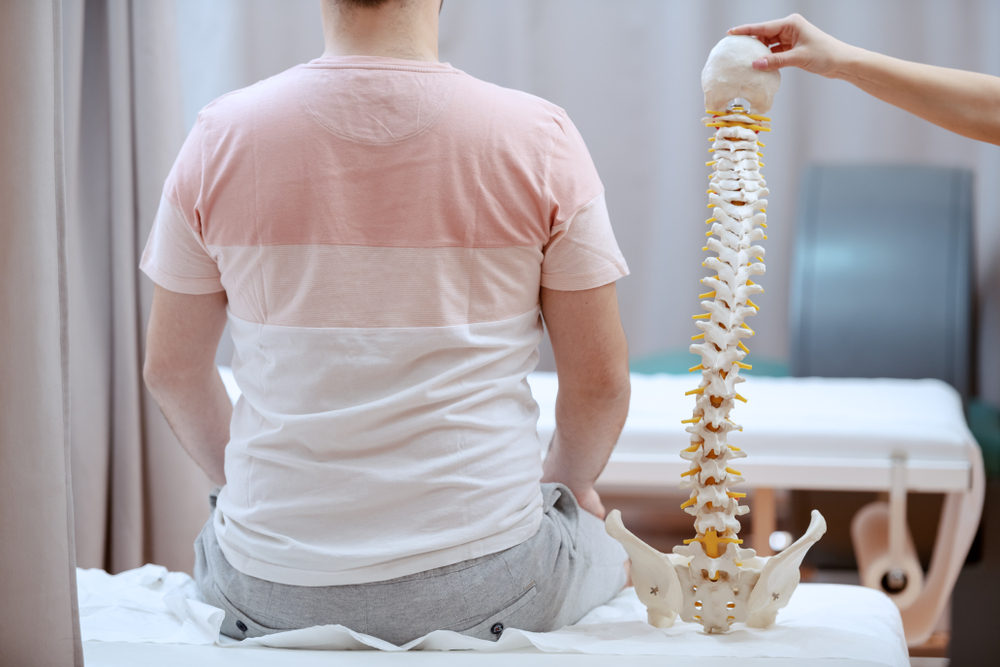
6 Types of Chiropractic Adjustments and How They Work
Chiropractic care is a popular form of healthcare focused on spinal health and overall well-being. Chiropractors use a variety of techniques to… Read More
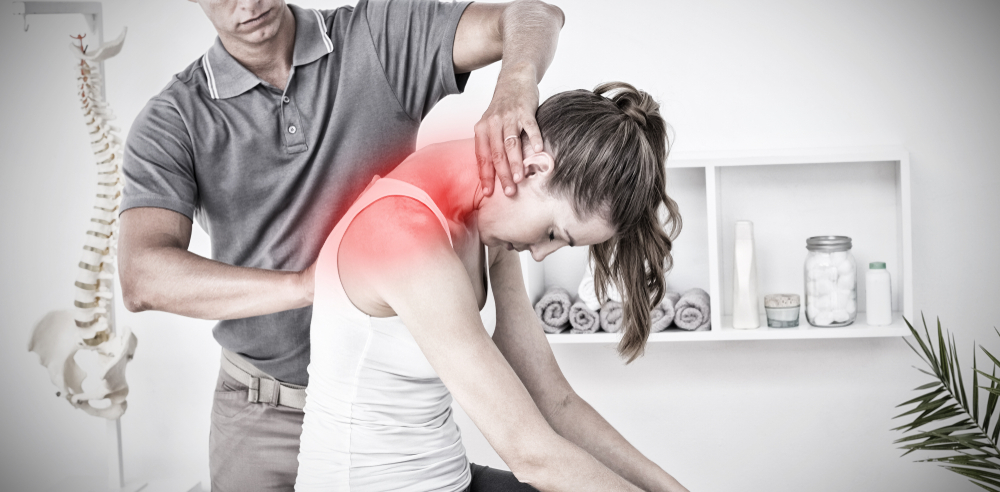
7 Researched Benefits of Chiropractic Adjustments
Chiropractic care focuses on maintaining spinal health and addressing misalignments that can cause a variety of health issues. The practice is growing… Read More
